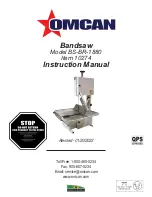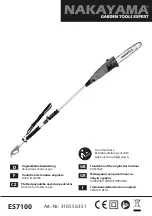
31
31
Vise Adjustment
To position the moveable vise jaw:
1. Turn vise handwheel (A) 1/2 turn counter-
clockwise.
2. Move rack block (B) to desired location by
sliding along the bed. Place the rack block
latch onto the rack.
3. Turn the handwheel to tighten the vise.
To adjust the vise for angle cutting:
4. Loosen bolts (D) and pivot vise jaw to
desired location.
5. Set the vise to desired angle, reinstall nuts and tighten the nut and bolt assemblies.
6. Make sure the movable vise jaw parallels to the fixed vise jaw.
7. Loosen the bolt (E) and adjust it until it is in parallel with the fixed vise jaw and tighten the
bolt.
Adjusting Feed Rate
When the descent control valve (A) is
turned clockwise as far as it can go,
the saw bow will not move down.
Turning the descent control valve
counter-clockwise, will regulate the
flow of oil from the cylinder and
determine the speed at which the saw
frame will lower and the blade will feed
through the work.
Many factors are involved to make
data charts practical on feed rates. As
a general rule, an even pressure
without forcing the blade gives best
results. Avoid forcing the blade at the start as this may shorten blade life and produce a bad cut.
By inspecting the chips while the cut is being made will indicate whether the feed rate is correct.
Fine powdery chip indicates a feed rate which is too light. The teeth are rubbing over the surface
instead of cutting.
Burned chip indicates excessive feed which causes the teeth to break off as the blade
overheats. The ideal feed rate is indicated by chip that have a free curl and this will give the
fastest cutting time and longest blade life.
A
B
C
E
D
A
Summary of Contents for BS-300M
Page 16: ...13 13 GETTING TO KNOW YOUR MACHINE S T U V W X R A G E D C F B H I J K L N P Q O M...
Page 29: ...26 26...
Page 42: ...39 39 PARTS DIAGRAM...
Page 43: ...40 40...
Page 52: ...49 49 ELECTRICAL COMPONENTS...
Page 54: ...51 51 ELECTRICAL SCHEMATIC...
Page 55: ...52 52 NOTES...
















































